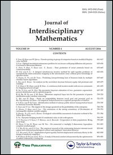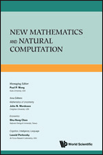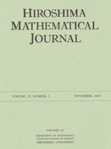
JOURNAL OF INTERDISCIPLINARY MATHEMATICS
Scope & Guideline
Fostering Innovation in Analysis and Applied Mathematics
Introduction
Aims and Scopes
- Mathematical Modeling and Analysis:
The journal publishes papers that develop mathematical models to analyze complex systems, particularly in areas such as epidemiology, fluid dynamics, and machine learning. - Computational Methods and Algorithms:
A significant emphasis is placed on the development and application of computational techniques, including numerical methods, optimization algorithms, and statistical analysis. - Interdisciplinary Applications:
The journal explores the application of mathematical theories and methods in various domains, including engineering, biology, finance, and social sciences, fostering interdisciplinary research. - Theoretical Advancements:
Research that contributes to the theoretical foundation of mathematics, including new mathematical constructs, theorems, and proofs, is a core focus. - Fuzzy and Soft Set Theories:
Papers that address fuzzy logic and soft set theories, particularly their applications in decision-making and optimization, are prevalent. - Fractional Calculus and Differential Equations:
The journal features research on fractional differential equations and their applications, reflecting a growing interest in non-integer order calculus. - Topological and Algebraic Structures:
Research exploring topological spaces, algebraic structures, and their properties forms a critical part of the journal's offerings.
Trending and Emerging
- Machine Learning and AI Applications:
The integration of machine learning and artificial intelligence into mathematical modeling and analysis is becoming increasingly prominent, reflecting a broader trend in the use of data-driven approaches in research. - COVID-19 Related Mathematical Models:
A surge in publications related to mathematical modeling of COVID-19 demonstrates the journal's responsiveness to global health challenges, highlighting the importance of applied mathematics in public health. - Fractional Calculus Applications:
The rising interest in fractional calculus, particularly its applications in various fields such as control theory and signal processing, marks a significant trend in recent publications. - Interdisciplinary Research Collaborations:
There is a growing trend towards interdisciplinary research, where mathematicians collaborate with experts from fields like biology, economics, and engineering, leading to innovative solutions to complex problems. - Fuzzy Logic and Decision-Making Models:
An increase in research focusing on fuzzy logic and decision-making models reflects a growing interest in handling uncertainty and imprecision in various applications. - Numerical Simulation Techniques:
The development and application of advanced numerical simulation techniques for solving complex mathematical problems are increasingly being emphasized in recent publications.
Declining or Waning
- Traditional Approaches to Differential Equations:
There appears to be a waning interest in classical methods for solving ordinary and partial differential equations, as newer computational and fractional techniques gain traction. - Basic Algebraic Structures:
Research centered on elementary algebraic structures, such as basic group theory or classical ring theory, is being published less frequently, possibly due to a shift towards more complex and applied mathematical frameworks. - Static Mathematical Models:
The emphasis on static models without dynamic or time-dependent considerations is declining, as researchers increasingly favor models that address real-time changes and interactions. - Conventional Statistical Methods:
There is a noticeable reduction in the publication of papers focusing solely on conventional statistical methods, as advanced machine learning techniques and big data analytics become more prominent.
Similar Journals

Bulletin of Computational Applied Mathematics
Fostering Collaboration in Computational AdvancesThe Bulletin of Computational Applied Mathematics, published by UNIV SIMON BOLIVAR, is an esteemed open-access journal dedicated to the fields of Applied and Computational Mathematics. Since its inception in 2013, this journal has provided a platform for researchers, professionals, and students to share innovative findings and methodologies that advance mathematical theory and application. With its ISSN 2244-8659, the bulletin has carved a niche in the academic community, maintaining a focus on practical computational issues while fostering the dissemination of research that aligns with contemporary challenges in the discipline. As reflected in its Scopus rankings and categorization within Q4 in both Applied and Computational Mathematics, the journal serves as a vital resource for those seeking to stay informed of the latest breakthroughs and trends. Based in Venezuela, the journal reflects a commitment to open access, ensuring that knowledge is readily available to a global audience, thus enhancing collaborative efforts in these critical mathematical domains.

Bulletin of the Institute of Mathematics Academia Sinica New Series
Connecting Researchers, Inspiring Mathematical Innovation.The Bulletin of the Institute of Mathematics Academia Sinica New Series is a prestigious international journal dedicated to the dissemination of high-quality research in the field of mathematics. Published by ACAD SINICA, this scholarly journal serves as a vital platform for researchers, professionals, and students alike to explore innovative mathematical theories, methodologies, and applications. With an ISSN of 2304-7909 and an E-ISSN of 2304-7895, the journal is committed to maintaining rigorous academic standards while fostering an environment of open discourse and collaboration within the mathematical community. Though specific impact metrics are still being developed, the journal is poised to contribute significantly to the advancement of mathematical knowledge, encouraging groundbreaking studies and interdisciplinary approaches. Researchers are invited to share their insights and benefit from this important resource, which supports the global advancement of mathematics from its base in Beijing, People's Republic of China.

TWMS Journal of Pure and Applied Mathematics
Innovating Solutions through Rigorous ResearchWelcome to the TWMS Journal of Pure and Applied Mathematics, a distinguished publication dedicated to advancing the field of mathematics through rigorous research and innovative applications. Published by the esteemed Institute of Applied Mathematics, this journal provides a platform for scholars and practitioners alike to share their findings and insights in both pure and applied mathematical disciplines. With a commitment to quality and integrity, the journal seeks to enhance the visibility and impact of mathematical research, reflected in its scholarly output. Although currently not an Open Access journal, the TWMS Journal aims to feature high-impact articles that contribute to both theoretical understanding and practical implementation. The journal’s address is located at Baku State University, ensuring its roots in a vibrant academic environment in Azerbaijan. As an essential resource in the mathematics community, the TWMS Journal of Pure and Applied Mathematics invites contributions that push the boundaries of knowledge and foster dialogue among researchers, professionals, and students.

Lobachevskii Journal of Mathematics
Fostering Scholarly Exchange in Diverse Mathematical FieldsLobachevskii Journal of Mathematics is a distinguished academic journal published by MAIK NAUKA/INTERPERIODICA/SPRINGER, dedicated to advancing research in the diverse field of mathematics. With an ISSN of 1995-0802 and an E-ISSN of 1818-9962, it has been a vital resource for scholars since its inception in 1999. Recognized for its contributions to the field, the journal proudly holds a Q2 ranking in the 2023 Mathematics (miscellaneous) category, placing it among the top half of its peers in Scopus, with a rank of 174 out of 399 and a 56th percentile standing. While currently not classified as an open-access journal, it effectively reaches a global audience through comprehensive dissemination of innovative mathematical research until 2024. Researchers, professionals, and students alike will find the Lobachevskii Journal a significant platform for the latest developments and theories in general mathematics, fostering an environment of scholarly exchange and growth.

BOLETIN DE LA SOCIEDAD MATEMATICA MEXICANA
Advancing Mathematical Discourse GloballyBOLETIN DE LA SOCIEDAD MATEMATICA MEXICANA, published by Springer International Publishing AG, is a pivotal journal in the field of mathematics, particularly recognized for its contributions to the miscellaneous mathematics category, holding a commendable Q2 ranking as of 2023. With an ISSN of 1405-213X and an E-ISSN of 2296-4495, the journal serves as a platform for disseminating high-quality research and innovations from both national and international scholars. Operating from Switzerland, the journal encompasses a broad range of topics within mathematics, supporting the development and communication of mathematical knowledge. Although it is not open access, it remains a respected source for researchers, professionals, and students seeking to deepen their understanding of mathematical concepts and applications. Published continuously and rigorously since its converged years, BOLETIN DE LA SOCIEDAD MATEMATICA MEXICANA plays a crucial role in advancing mathematical discourse and collaboration across disciplines.

Thai Journal of Mathematics
Exploring diverse mathematical landscapes for a global audience.Thai Journal of Mathematics (ISSN: 1686-0209) is a distinguished publication within the mathematical sciences, based at Chiang Mai University, Faculty of Science in Thailand. With a focus on diverse mathematical topics, the journal has been actively publishing since 2011 and aims to present original research, reviews, and innovative applications that contribute to the global mathematical community. Despite its current Q4 ranking in Mathematics (miscellaneous) and a modest percentile in Scopus Ranks, it serves as a vital platform for researchers and educators looking to disseminate their findings and engage with emerging trends in mathematics. The journal supports open sharing of knowledge, fostering collaborations and discussions across borders, which is essential for the advancement of mathematical education and research. Researchers, professionals, and students are encouraged to contribute and access valuable insights that shape the future of mathematics.

New Mathematics and Natural Computation
Pioneering Research in the Realm of Natural ComputationNew Mathematics and Natural Computation, published by World Scientific Publishing Co Pte Ltd, is a pivotal journal in the realms of applied mathematics and computational theories, catering to a diverse audience of researchers, professionals, and students. With an ISSN of 1793-0057 and E-ISSN 1793-7027, this journal serves as a critical platform for disseminating innovative research and methods that intertwine mathematical theories with natural computation processes. Operating from Singapore, it emphasizes accessibility and collaboration in advancing interdisciplinary knowledge, despite its current Q4 rankings across relevant categories such as Applied Mathematics and Human-Computer Interaction—highlighting the journal’s commitment to growth and improvement in a competitive publishing landscape. As a source of insightful findings and applications in mathematics and computer science, it invites contributors to explore the dynamic intersections between these fields and foster academic dialogue. Researchers aiming to engage with cutting-edge advancements will find this journal instrumental for their work from its inaugural issue in 2012 through its projected publications into 2024.

Journal of Applied Mathematics & Informatics
Exploring the Intersection of Theory and Practice in Mathematics.Journal of Applied Mathematics & Informatics is a peer-reviewed academic journal published by the Korean Society of Computational & Applied Mathematics (KSCAM), focusing on the integration and application of mathematical theories and computational techniques across various domains. Established in 2019, this journal serves as a platform for researchers, professionals, and students to share innovative methodologies, practical applications, and theoretical advancements in fields like analysis, applied mathematics, and computational theory. As a Q4 ranked journal according to the 2023 category quartiles in analysis, applied mathematics, computational mathematics, and miscellaneous mathematics, it provides a valuable, albeit niche, contribution to the academic landscape. While the journal currently operates without open access options, it aims to disseminate quality research to foster collaboration and knowledge exchange within the mathematics and computer science communities. Researchers looking to explore emerging trends and methodologies in applied mathematics and informatics will find an essential resource in this journal, which is based in Daejeon, South Korea.

Research in Mathematics
Exploring diverse mathematical landscapes with cutting-edge research.Research in Mathematics, published by TAYLOR & FRANCIS LTD, is an emerging academic journal dedicated to advancing the field of mathematics through innovative research and scholarship. With an E-ISSN of 2768-4830, this journal aims to foster discussion and dissemination of high-quality mathematical research across a broad spectrum of disciplines, including pure mathematics and applied mathematics. As part of its commitment to accessibility, Research in Mathematics operates on an open-access model, allowing researchers, professionals, and students to engage with groundbreaking studies without barriers. Despite its recent establishment since 2016, and with a current Scopus ranking that positions it in the lower percentile among its peers, the journal offers a platform for new voices in the mathematics community. Its objectives include enhancing visibility for novel mathematical concepts, methodologies, and applications that can significantly impact the academic and professional landscapes. Authors are encouraged to submit original research articles, review papers, and case studies that push the boundaries of mathematical knowledge.

Hiroshima Mathematical Journal
Exploring the Depths of Algebra, Analysis, and BeyondThe Hiroshima Mathematical Journal, published by Hiroshima University, Graduate School of Science, serves as a prominent platform for disseminating high-quality research in the field of mathematics. Established in 1959, the journal has been an integral part of the mathematical community, focusing on areas such as Algebra, Number Theory, Analysis, and Geometry and Topology. Although currently classified in Q4 quartile rankings within its categories, the journal is committed to advancing mathematical knowledge and fostering scholarly dialogue. Its accessibility, combined with its long-standing history, makes it an essential resource for researchers, professionals, and students dedicated to exploring and enhancing the mathematical sciences. For those interested in contributing or accessing cutting-edge research, the Hiroshima Mathematical Journal continues to uphold its mission of excellence in mathematical scholarship.